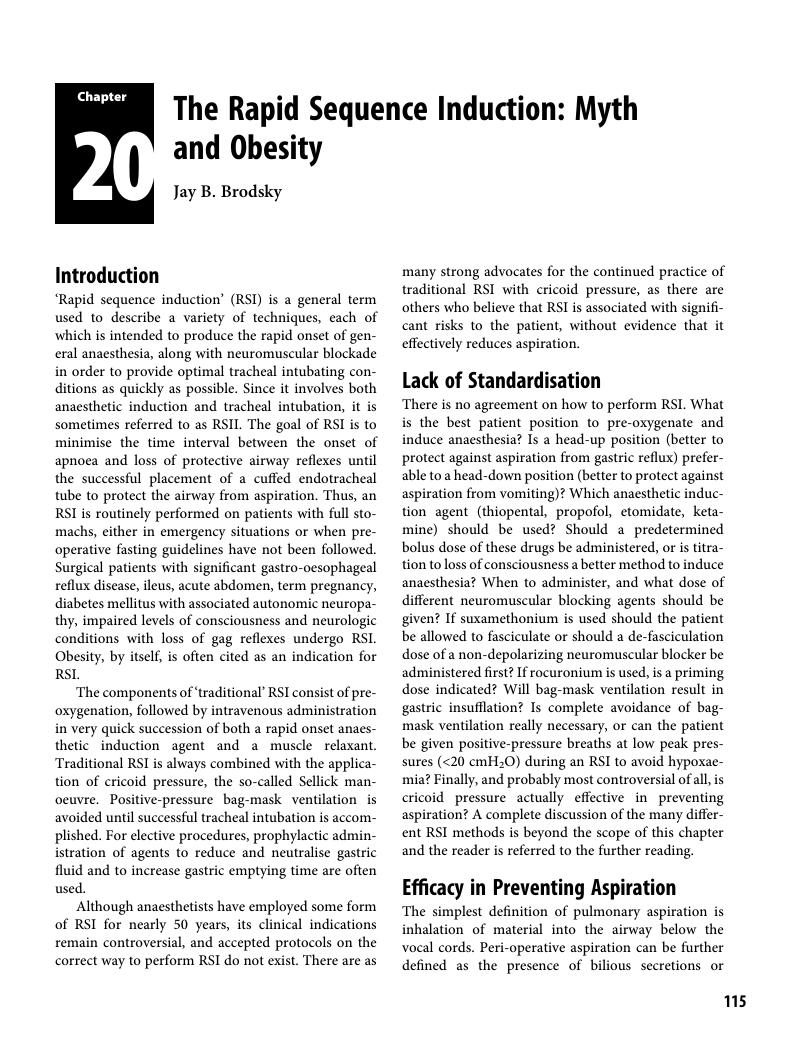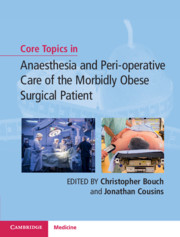Book contents
- Core Topics in Anaesthesia and Peri-operative Care of the Morbidly Obese Surgical Patient
- Core Topics in Anaesthesia and Peri-operative Care of the Morbidly Obese Surgical Patient
- Copyright page
- Contents
- Contributors
- Preface
- Abbreviations
- Section 1 Background to Obesity, Epidemiology and Anthropology
- Section 2 Pathophysiology of Obesity
- Section 3 Pre-operative Assessment and Preparation
- Section 4 Intra-operative Management
- Chapter 18 Patient and Operating Room Preparation for the Obese
- Chapter 19 Induction of General Anesthesia and Positioning in Obesity
- Chapter 20 The Rapid Sequence Induction: Myth and Obesity
- Chapter 21 Airway Management in Obesity
- Chapter 22 Maintenance of General Anaesthesia in Obesity
- Chapter 23 Techniques of Ventilation and the Pneumoperitoneum
- Chapter 24 Analgesic Techniques
- Chapter 25 Reversal and Emergence from Anaesthesia
- Chapter 26 The Morbidly Obese Parturient
- Chapter 27 Day Case Surgery for Obese Patients
- Chapter 28 Emergency Surgery and Trauma in the Obese
- Section 5 Post-operative Care
- Section 6 Bariatric Surgery
- Index
- References
Chapter 20 - The Rapid Sequence Induction: Myth and Obesity
from Section 4 - Intra-operative Management
Published online by Cambridge University Press: 24 September 2018
- Core Topics in Anaesthesia and Peri-operative Care of the Morbidly Obese Surgical Patient
- Core Topics in Anaesthesia and Peri-operative Care of the Morbidly Obese Surgical Patient
- Copyright page
- Contents
- Contributors
- Preface
- Abbreviations
- Section 1 Background to Obesity, Epidemiology and Anthropology
- Section 2 Pathophysiology of Obesity
- Section 3 Pre-operative Assessment and Preparation
- Section 4 Intra-operative Management
- Chapter 18 Patient and Operating Room Preparation for the Obese
- Chapter 19 Induction of General Anesthesia and Positioning in Obesity
- Chapter 20 The Rapid Sequence Induction: Myth and Obesity
- Chapter 21 Airway Management in Obesity
- Chapter 22 Maintenance of General Anaesthesia in Obesity
- Chapter 23 Techniques of Ventilation and the Pneumoperitoneum
- Chapter 24 Analgesic Techniques
- Chapter 25 Reversal and Emergence from Anaesthesia
- Chapter 26 The Morbidly Obese Parturient
- Chapter 27 Day Case Surgery for Obese Patients
- Chapter 28 Emergency Surgery and Trauma in the Obese
- Section 5 Post-operative Care
- Section 6 Bariatric Surgery
- Index
- References
Summary

- Type
- Chapter
- Information
- Core Topics in Anaesthesia and Peri-operative Care of the Morbidly Obese Surgical Patient , pp. 115 - 119Publisher: Cambridge University PressPrint publication year: 2018



